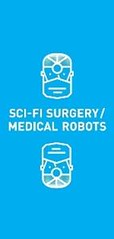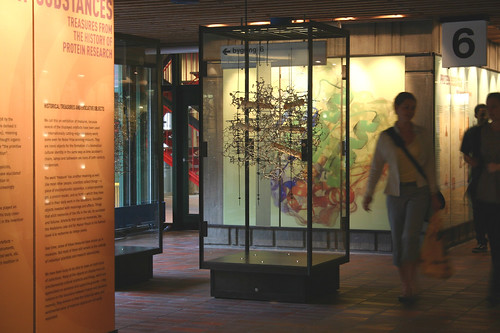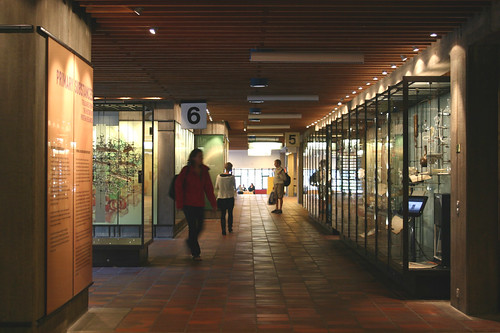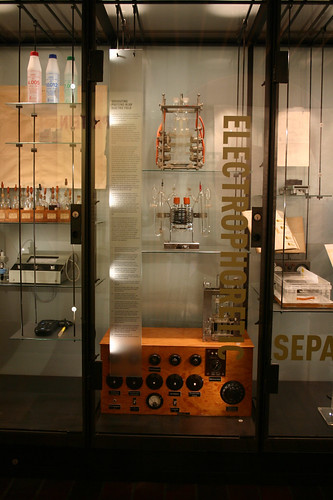For dem som ikke var til stede ved åbningen af vores nye udstilling ‘Primary Substances: Treasures from the History of Protein Research’ sidste fredag, bringes her dekan Ulla Wewers inledende tale i Dam-auditoriet. Talen sætter en fin ramme for, hvorfor udstillingen er opsat i Det Sundhedsvidenskabelige Fakultets hovedbygning på Blegdamsvej, og lægger bla. vægt på at det nye udstillingsområde i Panumbygningen vil kunne bidrage til skabelsen af en fakultetskultur og fakultetsidentitet.
Kære alle sammen
Velkommen til indvielsen af fakultetets nye udstillingsområde og åbningen af den første udstilling – ’Primary Substances: Treaures from the History of Protein Research’.
Udstillingen er udarbejdet af fakultetets eget museum, Medicinsk Museion, i anledning af åbningen af The Novo Nordisk Foundation Center for Protein Research. Det er proteincentret, der er anledningen til den aktuelle udstilling, og derfor er dagens event en kombination af udstillingsåbning og præsentation af og rundvisning i vores nye flotte proteincenter.
Forskning i proteiner er en strategisk vigtig opgave for et sundhedsvidenskabeligt fakultet. For tyve år siden ville man nok have sagt, at forskning i opbygningen af det menneskelige genom og de arvelige betingelser for sundhed og sygdom var den vigtigste strategiske opgave for biomedicinsk forskning.
Men efter at det humane genom blev kortlagt i begyndelsen af dette årti, er det strategiske tyngdepunkt blevet forskudt/har det strategiske tyngdepunkt ændret sig. Det er ikke længere livets bog og livets kode, der står i centrum for den biomedicinske forskning – der er nu fokus på, hvordan bogen bliver læst i cellernes maskineri.
Og i det maskineri spiller proteinerne den helt centrale rolle. Tusinder, måske hundredetusinder af forskellige slags proteiner – enzymer, membranproteiner, signalproteiner og peptider – danner et uhyre komplekst netværk af relationer, som får cellen, og dermed kroppen, til at fungere.
Proteiner har stået på dagsordenen for sundhedsvidenskabelig forskning i over hundrede år. Også her på SUND har mange generationer af forskere gjort en stor indsats for at forstå enkelte proteiners struktur og funktion. Med The Novo Nordisk Foundation Center for Protein Research går vi nu et skridt videre – Novo Nordisk Fondens donation på 600 mio. kr., betyder, at vi nu kan gøre en massiv indsats for systematisk at forstå opbygningen af proteomet.
Proteinforskning vil altså i de kommende år udgøre en væsentlig del af SUNDs strategiske satsning. Dette betyder også, at vi vil lægge vægt på proteiner og proteinforskning i vores forskningskommunikation. Både i den eksterne kommunikation til medier og befolkningen, hvor vi fortæller om de seneste forskningsresultater og deres betydning for sundhed og sygdom. Men også i den interne forskningskommunikation på SUND, hvor vi vil øge bevidstheden blandt studerende og ansatte om proteinforskningens betydning for hele fakultets arbejde.
Den interne forskningskommunikation handler ikke kun om at fortælle de seneste nyheder og resultater. Det handler i lige så høj grad om at skabe en fælles fakultetskultur. Et fakultet er mere end sine medarbejdere og forskningsartikler – det er også en fælles kultur, en fælles bevidsthed om, at det vi går og laver er vigtigt – en fælles identitet, der handler om at gøre SUND til et af Europas stærkeste sundhedsvidenskabelige fakulteter.
Som et bidrag til skabelsen af en sådan fælles fakultetsidentitet har vi etableret et nyt udstillingsområde her på Panum. Den aktuelle anledning var den planlagte proteinudstilling, som tidligere direktør for Novo Nordisk Fonden Gert Almind initierede planlægningen af – og som nu som Birgitte Nauntofte nuværende direktør for Novo Nordisk Fonden og Thomas Söderqvist fra Medicinsk Museion vil fortælle mere om et øjeblik. Men vi syntes ikke, det var nok med en enkelt udstilling – vi ville skabe et permanent udstillingsområde her på Panum.
Denne drøm blev til virkelighed ved hjælp af en generøs donation fra Kirsten og Freddy Johansens Lægevidenskabelige Fond, som har finansieret den lange smukke montrevæg i Vandrehallen, lige udenfor auditoriet og ned mod det nye kantineområde, som vi indviede tidligere i år. Montrerne er designet af arkitekt Mikael Thorsted, som ligeledes har stået for at bygge og installere.
Proteinudstillingen løber frem til januar 2010 – og herefter vil vi følge op med en serie af udstillinger om aktuelle og historiske emner, som er relevante for ansatte, studerende og gæster på SUND. Hvad der kommer hernæst vil vi ikke afsløre, men indtil da håber jeg, at I vil nyde ’Primary Substances: Treaures from the History of Protein Research’.
Velkommen!







